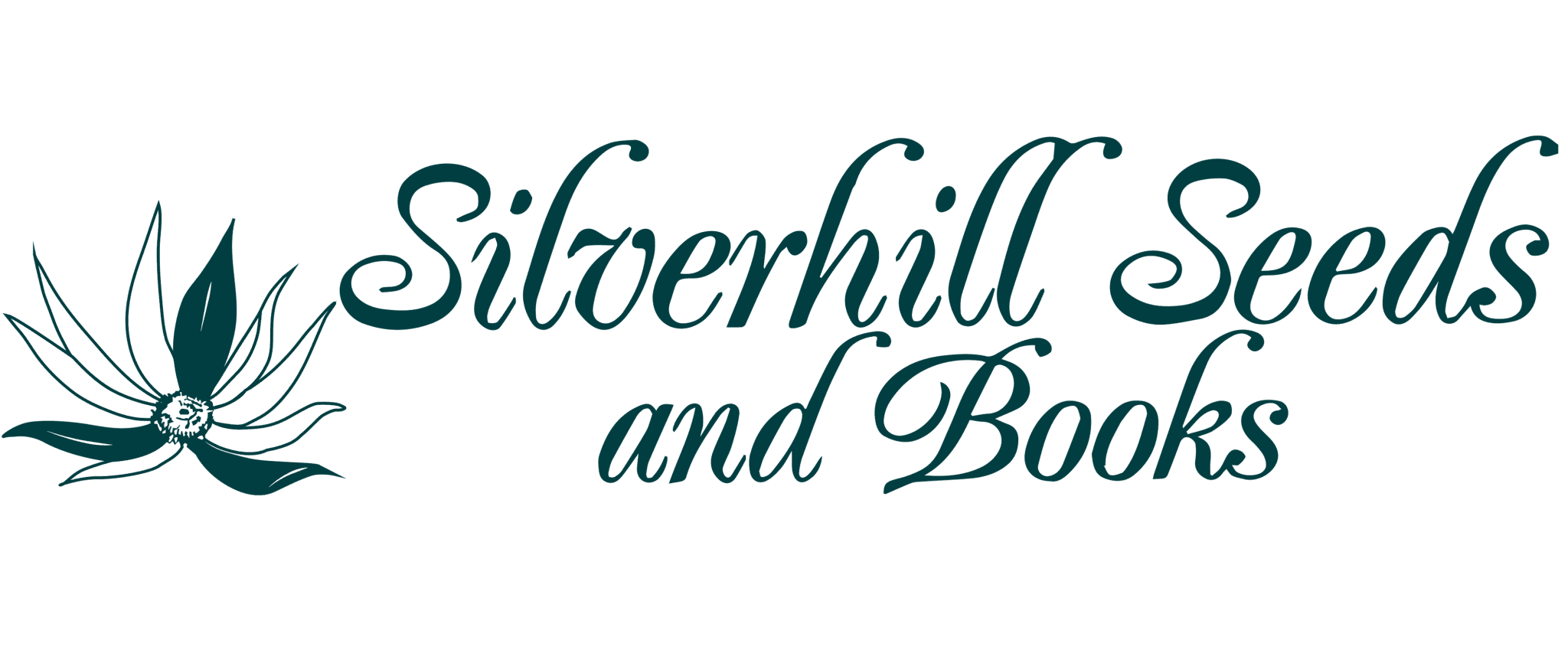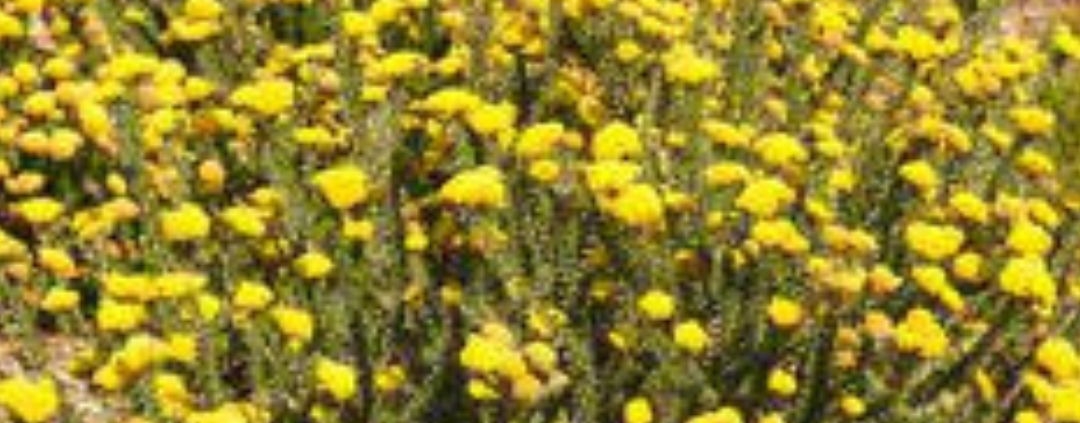Newsletter 3: July 2019
July 2019
By: Anthony Hitchcock
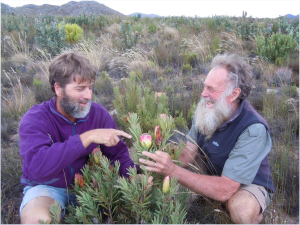
Rod and Anthony Hitchcock confer on this minature form of Protea repens
Dear Silverhill customers
February 2018 saw a great tragedy with the loss of Rod and Rachel Saunders to senseless murder. Their contribution and legacy to South African horticulture and botany is immeasurable. At the time of their deaths Rachel was on the cusp of completing her book on the Gladioli of South Africa. In documenting the genus for this monumental work they showed great dedication and determination to research, locate and record all the Gladioli on the subcontinent. Many a time they returned to localities again and again to try to find that elusive species. Far and wide, up to the top of the Drakensberg and other remote places in search of Gladioli species in flower. Rachel told me in early 2018 that she need only find and photograph one more species to have recorded them all. This was the culmination of a great adventure they undertook from the mid 1990s to collect as many South African plant species for their business and to introduce these to horticulturists, special collectors and researchers all around the world. Such was their success that they became legends in their time feted by the botanical and horticultural world. Their deaths therefore sent shockwaves around the world where they had many customers and friends. Questions were asked and assumptions were made that this would be the end of Silverhill Seeds.
We are happy to announce that Silverhill Seeds endures with Ondine Schrick having inherited the business. Ondine is a life long friend of Rod and Rachel and has been working at Silverhill since 1995. She has the years of experience and a dedicated team to keep the business going.
I have also joined the team to help fill the void left with the loss of Rod’s horticultural knowledge. I have been growing plants all my life and worked at Kirstenbosch National Botanical Gardens for 34 years. In that time I established the commercial production nursery that led to increasing the availability of indigenous South African plants to the nursery industry from a handful to well over 1000 species. This, along with the opening of the retail sales outlet run in collaboration with the Kirstenbosch Branch of the Botanical Society led to changing the face of horticulture in South Africa. I became Kirstenbosch Nursery Manager in 2002 and was responsible for managing the collections and conservation programme until I took early retirement in March 2018.
It was at Kirstenbosch that I met Rod who was Nursery Manager from the late 1980s to the mid 1990s. We forged a close friendship with our love of mountaineering, botany and horticulture. Rod and Rachel, my wife Wendy and I shared and enjoyed many wonderful mountain trips over the years. Every trip was dominated by plants and botanizing. We found, identified, photographed, collected and grew many unusual species from high mountains and remote places. Rod and my penchant for making up plant names was tempered by our other great mountain companion and botanist, Prof. Peter Linder, who ensured that we were kept under some control. However, we managed to contribute to Peter’s botanical skills with much needed red wine produced when camping high in the mountains.
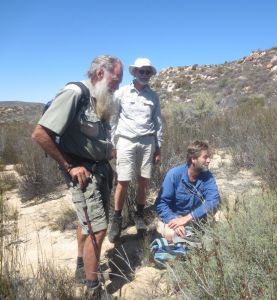
Rod with Peter Linder and Anthony Hitchcock on Nuweberg, south Cedarberg 2016
In late 2017 Rod and Rachel encouraged me to leave the increasingly stressful and politically charged Kirstenbosch work environment and come and work with them. I finally handed my notice to retire on the 16th February 2018 and immediately sent a whatsapp message to Rachel. Sadly, it was too late for her to receive it!
The next few months were traumatic for all close to Rod and Rachel, but we felt the need to keep their legacy going as we were sure they would have wanted us to. I do not think we will be able to emulate their tremendous achievements in harvesting as many plant species that they collected on their numerous trips, but we will do our best to provide the best service we can. Ondine has asked me to highlight some species that I think worth trying out. Please see selection below.
Selected species recommended to growers:
Lobelia valida ‘limestone lobelia’
Lobelia valida is a superb, fast growing herbaceous perennial up to 40cm high producing a breath-taking profusion of exquisite blue flowers during summer. The plants branch from the base producing attractive, densely crowded leaves with toothed margins. They thrive in alkaline or acidic, well-drained, organically rich soils and is particularly breath-taking when massed in groups. This rare South African plant is a superb perennial and easily grown from seed.
Metalasia aurea ‘Golden Metalasia’
Metalasia aurea is a densely branched South African shrub from the eastern Fynbos region. Metalasia muricata is close relative commonly used by landscapers in South Africa, but whereas it has white flowers, Metalasia aurea has exquisite golden-yellow flowers and a more compact growth habit ranging from 0.8 – 1.2m in height. In every way this species is superior to other Metalasias and new to horticulture. It is very easy to grow and maintain and flowers from autumn to early winter in South Africa (April – June). Its bright yellow flower heads illuminate the winter landscape where it is particularly effective in dense plantings. Seed is easy to germinate, which may be enhanced by smoke treatment. Soils, well drained neutral to acidic.
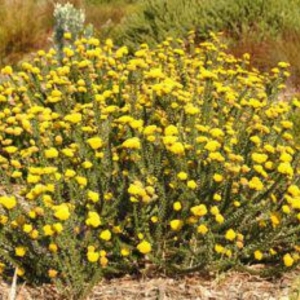
Podalyria buxifolia ‘box-leaf bush-sweetpea’
Podalyria buxifolia is another unheralded gem from the southern Cape region. It is new to horticulture, but we believe it has good potential and is an excellent plant for the gardener wanting to attract bees and butterflies to the garden. It has attractive, dark-green, glossy leaves and the most exquisite magenta, pea-like, scented flowers in summer. It is a spreading, well-branched, re-sprouting shrub growing to 1m high with a 2m spread. The leaves are simple, dark, glossy-green on top and have silky white hairs on the lower surfaces that produce a silvery sheen. It is easy to grow from seed which must be sown in the warm months. Soils should be well drained, and neutral to acidic. Treatment with hot water and a pre-emergence fungicide enhances germination. Flowering time is from August to April. Zone 8.
Sparmannia africana ‘Cape stock rose, wild stock rose, African hemp, Cape hollyhock’
Sparmannia africana is an attractive, much branched, bushy, soft-wooded evergreen shrub with a round growth habit usually 4 m tall but may grow up to 8m. The branches are soft, leaves are large, heart-shaped with toothed margins. The flowers are white with a mass of yellow and red-purple stamens in the centre. Much of the attraction of this flower is in the puff of brightly bicoloured stamens. The sterile outer stamens are yellow with purple tips while the inner ones, stained reddish-purple with purple tips, are fertile. Flowering occurs from mid-winter into early summer (June to November). Sparmannia africana is an easy-to-grow large shrub for shade or full sun. Zone 10.
Phylica pubescens ‘featherhead’
An exquisitely attractive fynbos shrub densely covered with luminous, hairy leaves where each hair seems to gather the sunlight and make it glow. Early morning or late afternoon sun shining behind the featherhead bush makes all other plants dull by comparison. The branches of this erect, 1.2-2 m tall bush are clothed with narrow, hair-covered leaves, which become crowded at the branch tips. Each branch ends in a lovely, compressed flowerhead, comprising rings of feathery bracts amongst which the tiny flowers nestle. They flower in autumn and winter (May to August). Seeds are easy to germinate when treated with hot water and a pre-emergence fungicide. Soils must be well drained and acidic. Zone 8.
Turraea obtusifolia ‘Small honeysuckle’
Turraea obtusifolia is an often-overlooked, beautiful, ornamental shrub with glossy dark green foliage displaying masses of showy white flowers in summer and decorative orange-red fruits in late summer to winter. The flowers are fragrant at night and are pollinated by moths. This plant does best when planted in a warm position against a wall. Sow Sp. Zone 10.
Phylica litoralis
Compact rounded shrub to 1m with dense arrangement of dark green leaves and attractive clusters of white flowers forming numerous button-like flower heads that cover the plant. Grows in full sun along the southern Cape coast and is an ideal coastal plant being resilient against the desiccating effects of salt-laden winds. Suitable filler in gardens near the coast or warm, sunny gardens. Germinate readily when pre-treated with hot water. Sow Spring. Zone 9
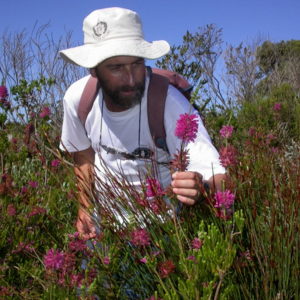
Anthony Hitchcock with the magnificent Erica verticillata (Extinct in the Wild) which has been restored to Rondevlei Nature Reserve
Erica verticillata (Extinct in the Wild)
This exquisite erica has been the subject of much conservation attention in South Africa and at Kirstenbosch National Botanical Garden. From being thought extinct in the early 1980s, it has resurfaced in several places around the world through the efforts of the British Heather Society, Kew RBG, private growers and famously from the Belvedere Palace collections in Vienna where it has been grown since the 1790s
Erica verticillata is a handsome, strong growing species averaging between 1.5 and 2m in height, but specimens can grow up to 3 m tall. It produces beautiful pink, tubular flowers arranged in neat whorls. Peak flowering is from January to March, but it is known to flower intermittently throughout the year. Nine distinct forms of this species have been discovered in collections around the world. For further information see: http://pza.sanbi.org/erica-verticillata and author with species in picture above. Please request as seed is limited due to poor seed set probably resulting from long-time isolation in cultivation. Seed produced germinates well when smoke treated. Seed supplied is open pollinated and therefore may yield a mixture of the forms. Sow Autumn. Zone 8.
- Instructions to sow in autumn refer to South African winter rainfall conditions, however on other areas we recommend sowing at the beginning of the growing season.
| Trees and Shrubs | Agathosma | ovata “Glentana” | 70cm evergreen, very aromatic shrub, finely textured foliage, pink fl Sp. Sow Au. Zone 8. | |
| Trees and Shrubs | Duvernoia | aconitiflora | 3m compact shrub, intriguing white fl Su. Sow Sp. Zone 9. | |
| Trees and Shrubs | Mitriostigma | axillare | Compact shrub in forests, sweetly scented white flowers ageing to yellow Sp – Su, round orange fruits. Sow Sp. Zone 10. | |
| Trees and Shrubs | Oldenburgia | grandis | “Mountain hunch back”, to 5m bushy shrub/tree, dark thick corky bark, large stiff leathery leaves, individual purple thistle-like flowers in large flat heads, fruit small brown, linear, flattened nutlet. Sow Au. Zone 8 | |
| Trees and Shrubs | Erica | baueri subsp baueri | “Bridal heath”, 1.5m, grey-green leaves, white/pink tubular flowers Spring-Autumn, cut fl. White & pinky-white forms also available.
The pink & white Still Bay form is the most attractive of this species due to its striking combination of white and deep pink flowers. Sow Au. Zone 8. |
|
| Trees and Shrubs | Erica | baueri subsp gouriquae | 2.5m dense shrub, erect leaves, 5-10 pink fl in loose spikes, limestone species, but grows well in acidic soils. This is a magnificent, very showy Erica listed as Endangered due to habitat destruction and alien invasive plants. It has lovely, tubular, pink flowers that cover the entire plant creating a magnificent show. It is easy to grow from seed which germinate better when smoke treated. Sow Au. Zone 8. | |
